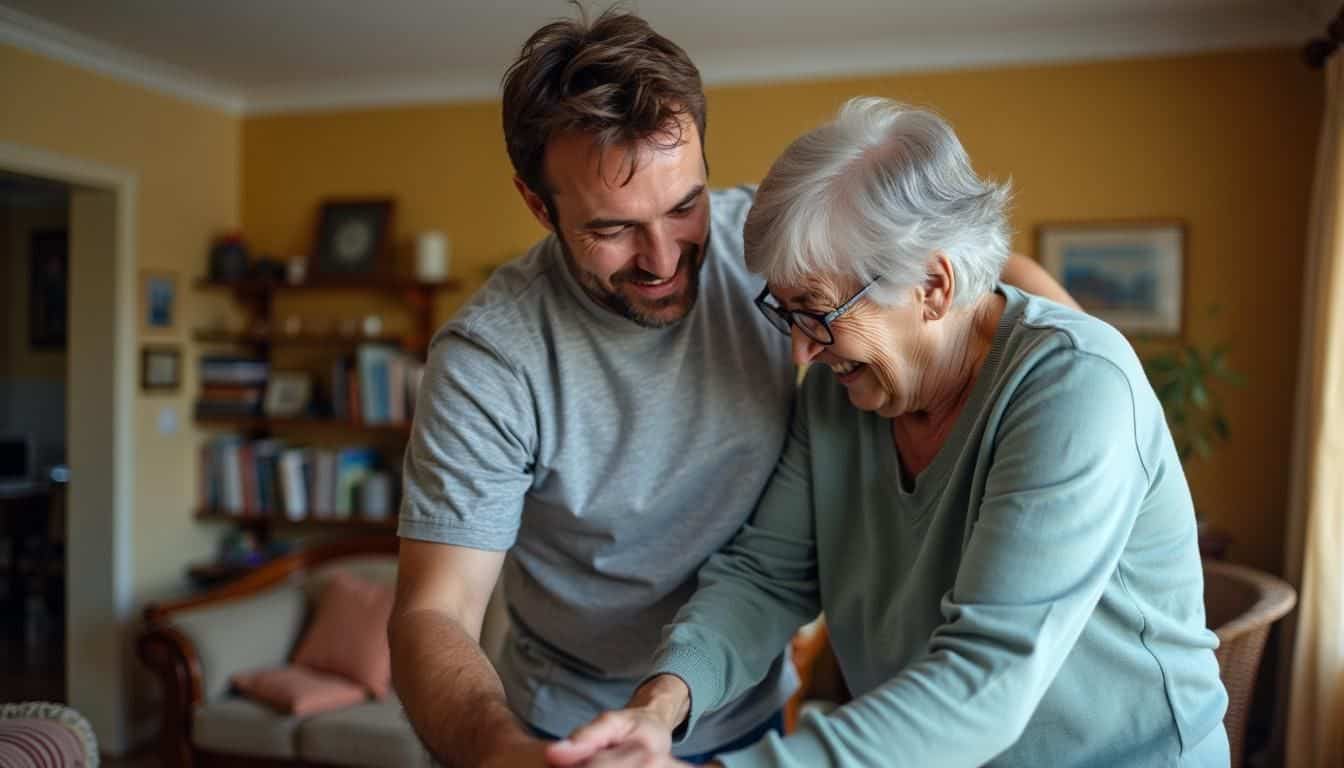Caring for someone with Parkinson’s can feel like a rollercoaster ride. Did you know that over 10 million people worldwide live with this condition? 3 Don’t worry – we’ve got your back.
Here are six game-changing tips to help your loved one thrive. Ready to make a difference? 2
Key Takeaways
Over 10 million people worldwide have Parkinson’s disease. Early signs include tremors, slow movements, stiff muscles, and balance problems.
Exercise, home safety changes, and assistive devices can help prevent falls and improve mobility for those with Parkinson’s.
Support groups, both in-person and online, provide emotional support and helpful tips for managing Parkinson’s symptoms.
Smart home technology and adaptive tools can increase independence and safety for people living with Parkinson’s disease.
Caregivers need to practice self-care and use available resources like respite care, support groups, and financial aid programs to avoid burnout.
Table of Contents
Key Aspects of Parkinson’s Disease

Parkinson’s is a tricky beast. It’s not just about shaky hands – it’s a whole bunch of symptoms that can make life… interesting. Let’s dive into what makes this disease tick and how folks are fighting back.
Identifying symptoms and progression
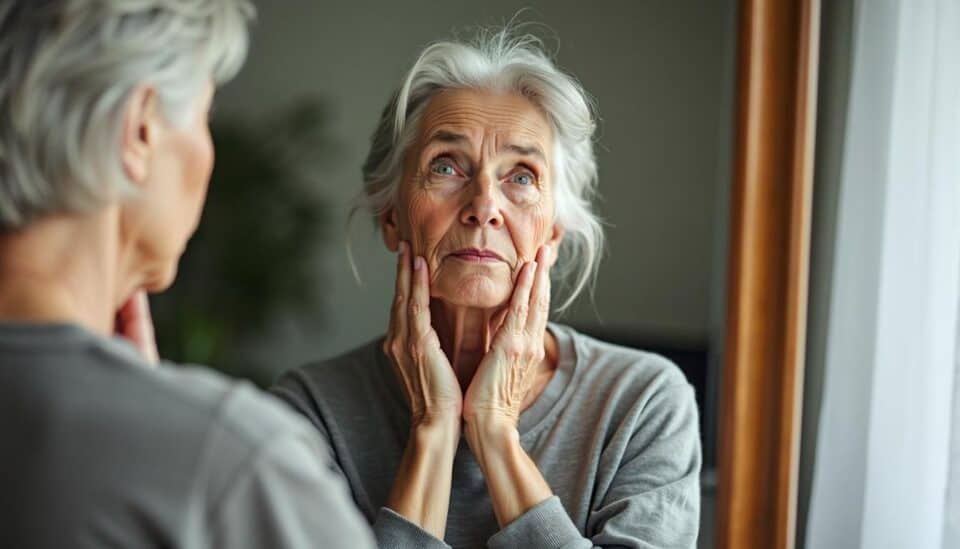
Spotting Parkinson’s early can make a big difference. Let’s look at the key signs and how they change over time.
- Shaky hands at rest: This is often the first thing people notice. Your hands might tremble when you’re not using them. 1
- Slow movements: Simple tasks like buttoning a shirt or getting out of a chair become harder. You might feel like you’re moving in slow motion.
- Stiff muscles: Your arms and legs may feel rigid. This can make walking tough and lead to a shuffling gait.
- Balance problems: You might feel unsteady on your feet or have trouble staying upright. 2
- Smaller handwriting: Your letters get smaller and closer together as you write. This is called micrographia.
- Loss of smell: You might not notice scents as well as before. This can happen years before other symptoms show up.
- Sleep issues: Trouble sleeping at night or acting out dreams could be early signs.
- Mood changes: About 35% of people with Parkinson’s get depressed. You might feel down or lose interest in things you used to enjoy.
- Voice changes: Your voice may get softer or sound hoarse. People might ask you to speak up more often.
- Facial masking: Your face may look serious or blank, even when you’re not feeling that way.
As time goes on, these symptoms usually get worse. But everyone’s journey is different. Now, let’s talk about how to make daily life easier for someone with Parkinson’s.
Exploring treatment options and therapies
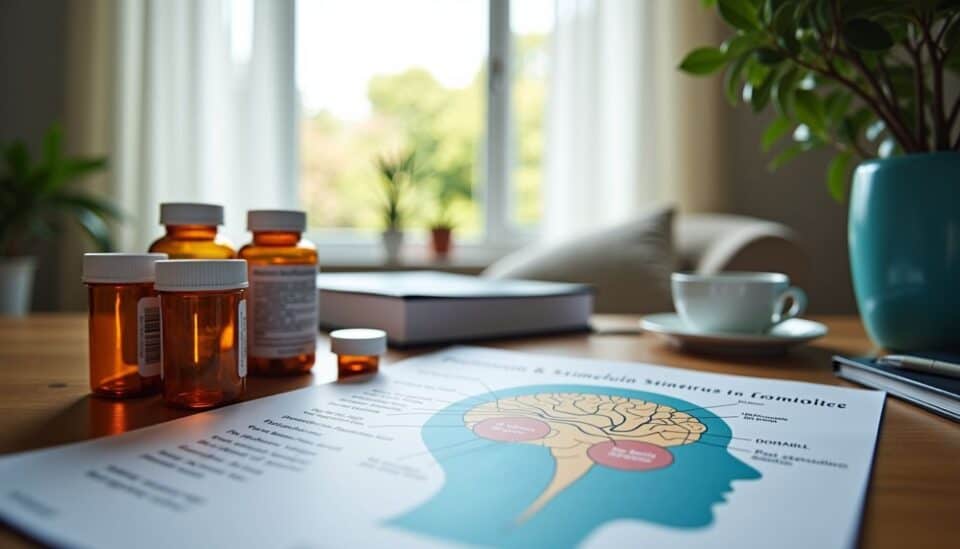
Now that we’ve covered spotting Parkinson’s signs, let’s talk about treatments. There’s no magic cure, but we’ve got ways to help folks feel better. Doctors often start with meds that boost dopamine in the brain.
The star player? Levodopa. It’s usually teamed up with carbidopa to pack a punch against those pesky movement issues. But that’s not all, folks! Some people might need a combo of different meds to keep symptoms in check. 3
For those tough cases, surgery could be an option. Deep brain stimulation (DBS) is like a pacemaker for your brain. Tiny wires go in your noggin and connect to a device in your chest.
It sounds sci-fi, but it can really help with tremors and stiffness. And guess what? New stuff is coming down the pike too. Scientists are working on cool things like using your own immune system to fight Parkinson’s.
They’re also looking at gut bacteria – who knew your tummy could be part of the solution? If you need help managing care at home, check out these Parkinsons home care services. 4
Supporting Daily Activities for Parkinson’s Patients

Daily life with Parkinson’s can be tough. But with a few tweaks, we can make things easier for our loved ones. Let’s dive into some simple ways to help out – from making meals a breeze to keeping the house safe.
These tips aren’t just helpful… they’re game-changers!
Enhancing mobility and fall prevention
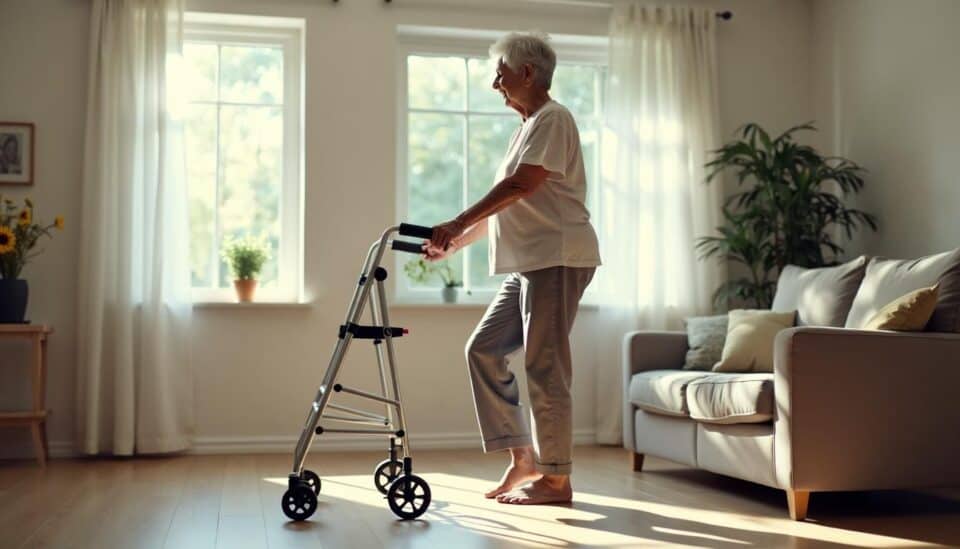
Staying active and safe is key for folks with Parkinson’s. Let’s look at some ways to boost mobility and dodge those pesky falls.
- Get moving: Exercise is your best friend. Try walking, swimming, or dancing – whatever floats your boat. It’ll help keep those muscles strong and limber. 6
- Watch your step: Shuffling or taking short steps? That’s common with PD. Focus on lifting your feet and taking bigger strides. It might feel odd at first, but it’ll help you move better. 5
- Clear the clutter: Take a good look around your home. Get rid of throw rugs, loose cords, or anything else that might trip you up. A clear path is a safe path!
- Grab some support: Install grab bars in key spots like the bathroom or bedroom. They’re great for steadying yourself when you need a little extra help.
- Light it up: Make sure your home is well-lit. Good lighting helps you see potential hazards and move around more confidently.
- Take it slow: Rushing is a recipe for disaster. Give yourself plenty of time to get ready and move from place to place. Slow and steady wins the race!
- Gear up: Consider using a walker or cane if balance is an issue. They’re not just for show – they can really boost your confidence and keep you upright. 6
- Stay hydrated: Dehydration can make you dizzy and more likely to fall. Keep a water bottle handy and sip throughout the day.
- Mind your meds: Some PD meds can affect balance. Chat with your doc about the best times to take them to minimize fall risk.
- Practice balance exercises: Try standing on one foot or doing tai chi. These activities can improve your balance and make you steadier on your feet.
Improving communication and social interactions

Moving from mobility to communication, we face new hurdles. Talking and socializing can be tough for those with Parkinson’s, but there are ways to help. 7
- Speak up: Encourage your loved one to talk louder. Parkinson’s often makes voices soft, so remind them to use their “outside voice” even indoors.
- Slow down: Rush less, listen more. Give them time to form words and thoughts. Patience is key here.
- Face-to-face chats: Look at each other when talking. This helps with lip-reading and picking up facial cues.
- Write it out: Keep a notepad handy. Sometimes writing is easier than speaking for Parkinson’s folks.
- Tech tools: Try speech-to-text apps or voice amplifiers. These gadgets can be game-changers for clear chats.
- Practice makes perfect: Do speech exercises together. Tongue twisters and singing can help keep speech muscles strong.
- Group therapy: Join a Parkinson’s support group. It’s a safe space to practice talking and make new friends. 8
- Body language matters: Use gestures and facial expressions to add meaning to words. It helps get the message across.
- Quiet, please: Cut down background noise when chatting. Turn off the TV or move to a quieter spot.
- Stay social: Don’t let speech issues lead to isolation. Keep up with hobbies and friends – it’s good for the brain and soul.
Organizing medication schedules
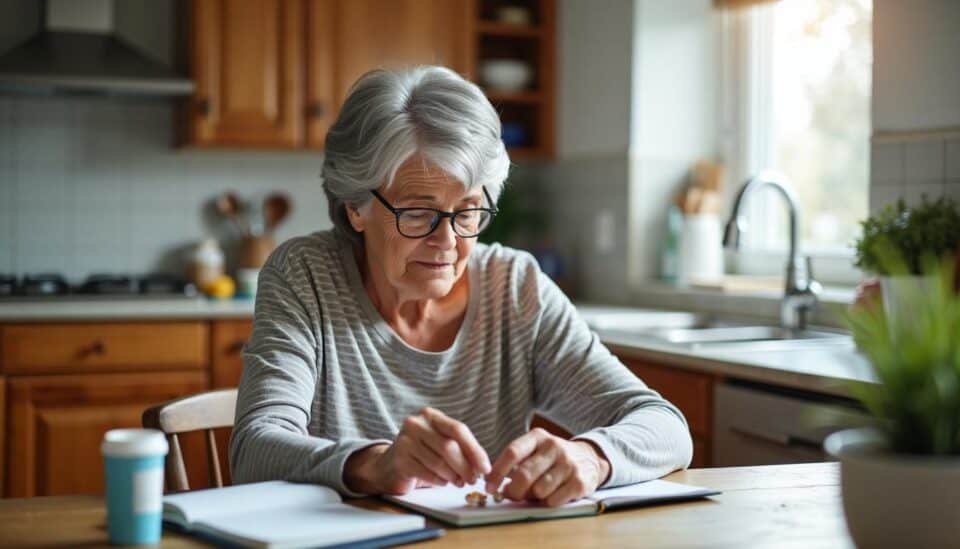
Keeping track of meds is key when helping someone with Parkinson’s. Let’s look at some ways to make this task easier and less stressful.
- Use a pill organizer: A box with slots for each day helps sort meds. It’s a simple tool that can prevent mix-ups and missed doses. 9
- Set up reminders: Phone apps or alarms can ping when it’s time for meds. This takes the guesswork out of timing and helps stick to the schedule.
- Make a med chart: Write down all meds, doses, and times on a chart. Hang it where it’s easy to see – like on the fridge.
- Plan meals around meds: Some drugs work best on an empty stomach. Others need food. Plan smaller, more frequent meals to fit the med schedule. 9
- Keep a log: Jot down when meds are taken and any side effects. This info helps docs adjust treatment as needed.
- Store meds safely: Keep pills in a cool, dry place away from direct light. This helps them stay effective longer.
- Use pill splitters if needed: Some meds come in doses that are too big. A pill splitter can help get the right amount safely.
- Check for drug interactions: Ask the pharmacist about how meds mix with each other and with foods. This helps avoid unwanted effects. 10
Emotional and Social Care for Parkinson’s Disease
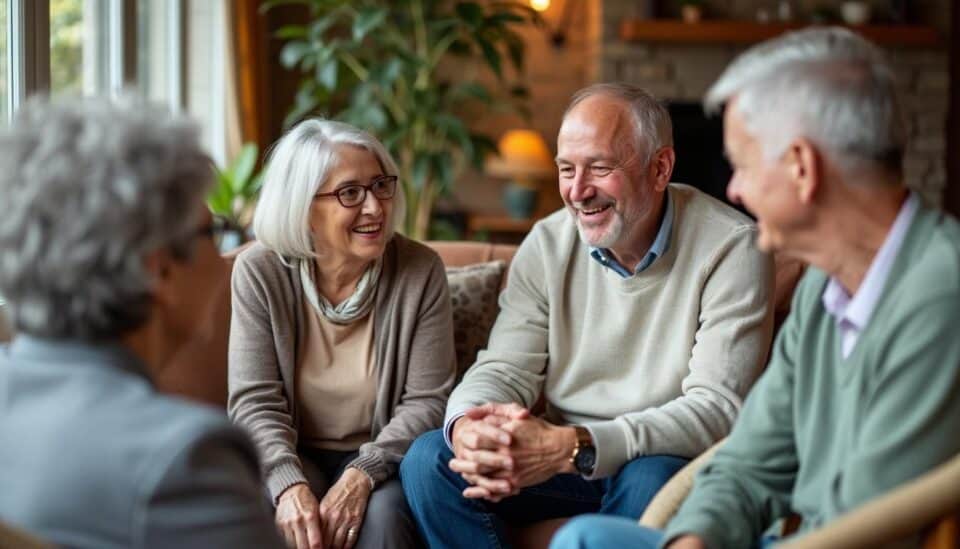
Parkinson’s isn’t just about shaky hands – it’s a rollercoaster for the heart and mind too. Joining a support group or chatting with a therapist can be a game-changer, helping folks with PD feel less alone and more understood.
Promoting support group involvement

Support groups can be a game-changer for folks with Parkinson’s. They’re like a cozy club where everyone gets it. You’ll meet new pals, swap stories, and learn cool tricks for dealing with symptoms.
It’s not just for those with PD – family and friends are welcome too! These groups often dish out info on the latest treatments, which is super helpful. 8
Online support is another awesome option. It’s perfect for those days when leaving the house feels like climbing Mount Everest. You can chat with others from your comfy couch, share your ups and downs, and get a virtual hug when you need it most.
Plus, it’s a great way to stay connected and build those all-important coping skills. 11
Joining a support group is like finding your tribe. It’s where understanding meets friendship, and where shared experiences become shared strength. – Anonymous PD Warrior
Creating a supportive home environment

A cozy home can make a world of difference for someone with Parkinson’s. Start by clearing out clutter and adding grab bars in key spots. Good lighting is a must – it cuts down on falls and helps folks see better.
In the kitchen, pull-out shelves and easy-to-reach cabinets are game-changers. They mean less bending and stretching, which can be tough with Parkinson’s. 12
Smart home gadgets are pretty cool too. They let people control lights and appliances without moving around too much. It’s all about making life easier and safer. Plus, these changes can help folks keep their independence longer.
That’s huge for mental health and quality of life. Caring for a disabled adult at home gets easier with these tweaks. 13
Home Modifications for Safety and Accessibility
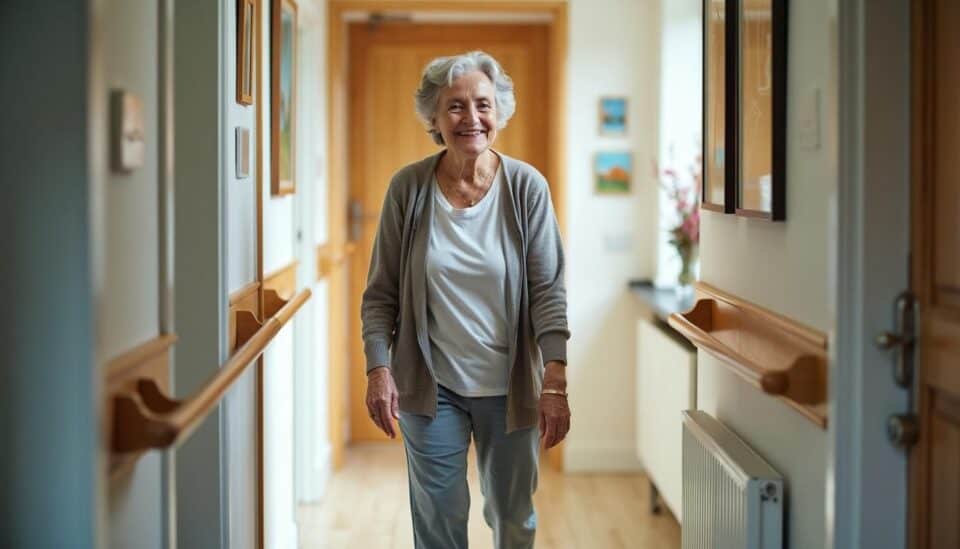
Home tweaks can make a big difference for folks with Parkinson’s. Simple changes – like adding grab bars or removing throw rugs – can help prevent falls and boost independence.
These small steps can turn a tricky home into a safe haven… and give everyone peace of mind.
Adapting living spaces for safety
Living spaces need tweaks for folks with Parkinson’s. Let’s dive into some nifty ways to make homes safer and comfier:
- Light it up: Bright spaces cut fall risks. Add lamps in dark corners and use motion-sensor lights for nighttime trips. 14
- Clear the clutter: Toss or move items that could trip someone up. Loose rugs? Bye-bye! Cords? Tuck ’em away.
- Grab bars are your BFFs: Pop these handy helpers in bathrooms, near beds, and along hallways. They’re lifesavers for balance. 15
- Kitchen makeover time: Pull-out shelves and easy-reach cabinets are game-changers. No more straining or bending!
- Widen doorways: If possible, make ’em broader. It’s easier to move through with walkers or wheelchairs.
- Smooth moves: Replace thick carpets with non-slip flooring. It’s safer and easier to walk on.
- Stair solutions: Add railings on both sides of stairs. For single-story living, consider a stairlift or move the bedroom downstairs.
- Bathroom bliss: Install a raised toilet seat and a walk-in shower. Shower chairs are super helpful too.
- Tech to the rescue: Voice-activated gadgets can control lights, thermostats, and more. They’re pretty cool and super useful!
- Cozy seating: Choose chairs with firm cushions and armrests. They’re easier to get in and out of.
Utilizing tools and technology
After making your home safer, it’s time to look at cool gadgets that can help. Tech tools are game-changers for folks with Parkinson’s. They make life easier and more fun!
Smart home tech is a big win. It lets people control lights and appliances with their voice or a tap on their phone. No more fumbling with switches! Wearable devices are also super handy.
They track symptoms and send info to doctors in real-time. This helps catch problems early. 16 Plus, telemedicine is a lifesaver for those far from hospitals. You can chat with your doc from your couch! 16 These tools boost independence and quality of life.
They’re not just neat – they’re life-changing.
Caregiver Support and Resources
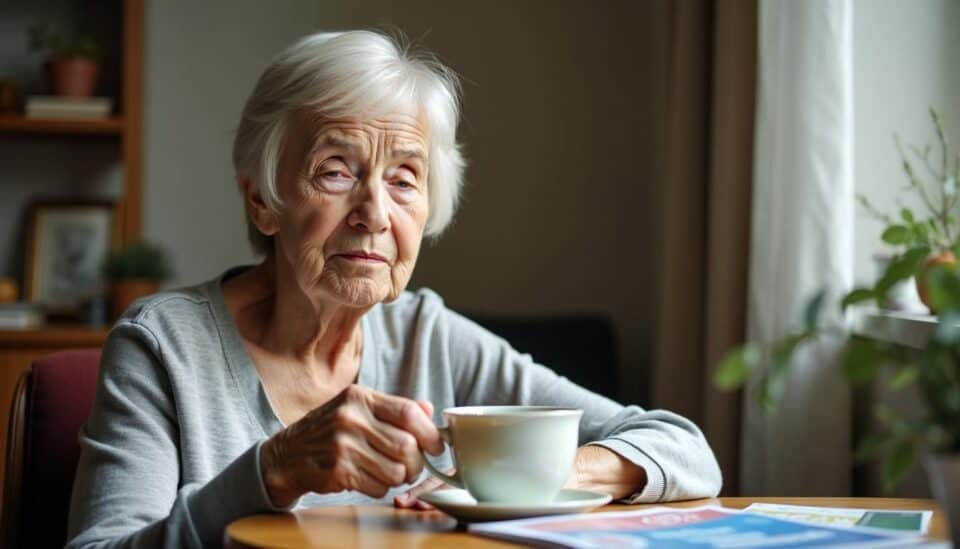
Caring for someone with Parkinson’s can be tough. It’s vital to take care of yourself too – you can’t pour from an empty cup! There are lots of resources out there to help… from support groups to respite care options.
Emphasizing the need for caregiver self-care
Caring for someone with Parkinson’s can be challenging. It’s easy to overlook your own needs when you’re focused on helping others. But here’s the thing: you can’t give what you don’t have.
Taking care of yourself isn’t selfish—it’s essential. Research indicates that high caregiver stress results in poorer health for both patients and caregivers. 18 The COVID-19 pandemic has highlighted this even more.
Self-care goes beyond bubble baths and face masks. It’s about meeting your basic needs. Eat well, sleep enough, and stay active. Connect with friends or join a support group. 12 Don’t hesitate to ask for help—it shows strength, not weakness.
Coping with health setbacks is difficult. Take breaks when you need them. Your well-being is important too.
Self-care is not a luxury. It’s a necessity for caregivers.
Providing resources for caregiver assistance
Caring for a loved one with Parkinson’s can be tough. But you’re not alone – there’s help out there. Here’s a list of resources to make your job as a caregiver easier:
- Parkinson’s Foundation Helpline: Call 1-800-4PD-INFO for free advice from experts. They’ll answer questions and point you to local help. 19
- Support Groups: Join a group to meet others in your shoes. You’ll swap tips and feel less alone. The Parkinson’s Foundation can help you find one nearby.
- Online Forums: Can’t make it to a group? Try web forums. You can chat with other caregivers 24/7 from home. 12
- Respite Care: Take a break! Short-term care services can watch your loved one while you recharge. Ask your doctor about options in your area.
- Home Health Aides: Hire help for daily tasks like bathing or dressing. It’ll free up your time and energy.
- Education Programs: Learn more about Parkinson’s and caregiving. Many hospitals offer free classes. You’ll feel more confident in your role.
- Financial Aid: Caring can be costly. Look into grants or low-cost programs. The social worker at your clinic might know of local options.
- Legal Resources: Get help with power of attorney or healthcare directives. Many lawyers offer free consults for caregivers.
- Meal Services: Cooking can be a chore. Try meal delivery services or local programs that bring food to seniors.
- Transportation Help: Find services that can drive your loved one to appointments. It’ll save you time and stress.
People Also Ask
What are some daily challenges faced by people with Parkinson’s disease?
People with Parkinson’s disease often struggle with fatigue, constipation, and speech problems. They may also face issues like muscle tension, slurred speech, and difficulty with daily living tasks. It’s like trying to run a marathon with weights on your ankles – everything’s a bit harder.
How can a health care professional help someone with Parkinson’s disease?
A dream team of pros can make a world of difference. Neurologists, physical therapists, and speech-language pathologists are key players. They can offer treatments like resistance training, speech therapy, and even explore options like focused ultrasound. It’s like having a pit crew for your body and brain!
What role does diet play in managing Parkinson’s disease?
A balanced diet is crucial. It’s not just about eating your veggies (though that helps). Proper nutrition can ease symptoms like constipation and help with medication absorption. Think of food as your body’s fuel – the right mix keeps your engine running smoothly.
How important is exercise for someone with Parkinson’s disease?
Exercise is a superhero in the fight against Parkinson’s. From aerobics to flexibility training, moving your body can improve symptoms and boost mood. It’s like oiling a rusty machine – everything works better with regular movement.
What are some ways to support the emotional health of someone with Parkinson’s?
Emotions can be a rollercoaster with Parkinson’s. Encouraging relaxation techniques, meditation, or even pet therapy can help. Don’t forget about mental health professionals – they’re like personal trainers for the mind. Remember, a laugh a day keeps the doctor away!
How can caregivers avoid burnout when helping someone with Parkinson’s?
Caregiver burnout is real, folks. It’s crucial to take breaks, join support groups, and practice self-care. Think of it like putting on your own oxygen mask before helping others. A happy, healthy caregiver is the best medicine for someone with Parkinson’s.
References
^ https://www.ncbi.nlm.nih.gov/pmc/articles/PMC4517533/
^ https://www.ncbi.nlm.nih.gov/pmc/articles/PMC8150663/
^ https://www.ncbi.nlm.nih.gov/pmc/articles/PMC10051786/
^ https://www.hopkinsmedicine.org/health/conditions-and-diseases/parkinsons-disease/6-medication-free-ways-to-feel-better-with-parkinsons-disease
^ https://www.parkinson.org/library/fact-sheets/fall-prevention
^ https://www.ncbi.nlm.nih.gov/pmc/articles/PMC10585979/
^ https://www.ncbi.nlm.nih.gov/pmc/articles/PMC9313789/
^ https://www.ncbi.nlm.nih.gov/pmc/articles/PMC6949188/
^ https://www.medicalnewstoday.com/articles/how-to-take-care-of-a-person-with-parkinson-disease (2023-12-21)
^ https://www.ncbi.nlm.nih.gov/pmc/articles/PMC7563525/
^ https://www.ncbi.nlm.nih.gov/pmc/articles/PMC9377481/
^ https://www.ncbi.nlm.nih.gov/pmc/articles/PMC7025758/
^ https://www.ncbi.nlm.nih.gov/pmc/articles/PMC10010098/
^ https://todayshomeowner.com/safety/guides/how-to-adapt-your-home-for-parkinsons/ (2024-03-31)
^ https://www.helpinghandshomecare.co.uk/care-advice/how-to-adapt-your-home-if-you-have-parkinsons/
^ https://www.ncbi.nlm.nih.gov/pmc/articles/PMC5014594/
^ https://www.parkinson.org/living-with-parkinsons/management/activities-daily-living/home-safety
